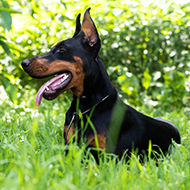Study shares canine ear-cropping demographics

Lack of import regulations and social media influence are thought to have fuelled this trend.
SAVSNET, the University of Liverpool's Small Animal Veterinary Surveillance Network, has shared details of a new study providing insight into the breeds, ages and geographical origins of dogs with cropped ears in the UK.
Despite the procedure having been illegal in the UK since 2006, veterinary professionals have seen a concerning increase in ear-cropped dogs. Analysing electronic health data from a network of more than 500 UK veterinary practices, researchers identified 132 dogs with cropped ears between 2015 and 2022.
Fifth-year veterinary student at the University of Liverpool who carried out the work for the project, said: “I was acutely aware of campaigns by the RSPCA and others raising awareness of the rise in reported cases of ear cropping.
“This new SAVSNET study provides important new insights into the demographics of affected dogs that could help inform both policy and targeted education to tackle this growing problem.”
Evidence of importation was found in 84 per cent of cases identified, most commonly from Romania, Hungary, Bulgaria, Serbia, Spain, Poland and Ireland. A minority of the dogs appeared to have been cropped illegally in the UK.
Paula Boyden, director at Dogs Trust, who provided a Canine Welfare Grant for the project, commented: “The latest SAVSNET research provides essential information on breeds, ages and origins of dogs with cropped ears in the UK which will be extremely useful in helping to target education to the public about the cruelty and impact of this practice.”
A significant statistical association was made with breed, with guarding breeds including American bulldogs, Dobermanns, Italian mastiffs, bulldogs and mastiffs being more likely to have cropped ears than other breeds.
Ear-cropped dogs were also predominantly aged one years old or younger, and were significantly less likely to have been neutered than the control sample.
Paula continued: “Despite ear cropping being illegal in both the UK and the EU, we are seeing increasing numbers of dogs who have been subjected to the unnecessary procedure both in the media and through our rehoming centres.
“There is no medical reason to crop a dog’s ears. The process can be extremely painful, result in complications and can cause long term issues such as inhibiting a dog’s ability to communicate. Education is key to stopping this abhorrent practice.”
'Dogs with cropped ears in the UK: A population-based study using electronic health records' is published in Veterinary Record.



 The RCVS has announced a new version of its 1CPD mobile app, with enhanced features for veterinary surgeons and veterinary nurses to record their continuing professional development.
The RCVS has announced a new version of its 1CPD mobile app, with enhanced features for veterinary surgeons and veterinary nurses to record their continuing professional development.